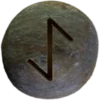Last Updated on September 26, 2024

Gjöll is one of the rivers that flows from Hvergelmir, often considered part of the group of Élivágar rivers. Its name translates to “loud noise” or “roaring,” reflecting its powerful and constant current. Gjöll serves as a boundary river, dividing the world of the living from the realm of the dead. In Asatru, it symbolizes the transition between life and death and the journey every soul must eventually take.
Gjöll flows near the entrance to Hel, the land of the dead, where those who did not die in battle reside. The river runs beneath the bridge, Gjallarbrú. Gjallarbrú is guarded by Móðguðr, a fierce maiden who challenges any soul wishing to cross. In Asatru, this imagery underscores the concept of fate and the inevitability of death. Gjöll acts as the physical manifestation of that boundary. It reinforces the cyclical nature of existence and the journey every being undertakes from life to death and beyond.
As part of Élivágar, Gjöll plays a key role in the creation and sustenance of life. It balances the forces of life and death, offering an essential reminder that endings are also beginnings. Followers of Asatru honor this river’s role in maintaining the natural order, seeing it as a pathway guiding souls through the transitions of existence.
Gjöll’s Rune Connection
The Elder Futhark rune associated with Gjöll is Eihwaz, which represents the yew tree, a symbol of life, death, and continuity. Eihwaz signifies the connection between different realms and the passage between them, much like Gjöll connects the world of the living to the realm of the dead.
Eihwaz also emphasizes resilience and inner strength in the face of challenges, which resonates with the symbolism of crossing the river. To followers of Asatru, the river encourages reflection on the meaning of life’s transitions. Gjöll reminds believers to approach death not with fear but with reverence. They acknowledge it as a necessary part of the eternal cycle that guides the world forward.

